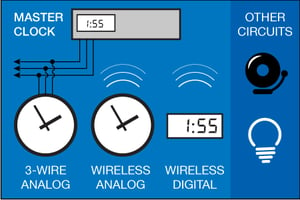 When you're shopping for anything new, it's common sense to think about how it will complement what you already have — the same holds true when you're investing in new clocks for your school. Whether you're just replacing a few old clocks, or have a whole new wing to integrate into your existing school clock and bell systems, there are a few factors to consider that will ensure a smooth transition. Short on time? Check out a short video on clock integrations here.
When you're shopping for anything new, it's common sense to think about how it will complement what you already have — the same holds true when you're investing in new clocks for your school. Whether you're just replacing a few old clocks, or have a whole new wing to integrate into your existing school clock and bell systems, there are a few factors to consider that will ensure a smooth transition. Short on time? Check out a short video on clock integrations here.
When you're replacing clocks
We'll start with the easier of the two scenarios that require new clock integration. If you're merely replacing one clock with another, your task is relatively simple: Ensure the new clock will be compatible with the master controller.
The master controller broadcasts time signals to each individual clock on a predetermined interval, and the clock has to be set to receive the signal on that basis. So, to make sure your replacement clock is compatible, call the manufacturer and tell them the model number of your old clock; they should be able to tell you what new models will be compatible.
Keep in mind that the replacement clock doesn't have to come from the same manufacturer as the old clock. It's like with tires – you can mix Goodyear with Firestone if that's what works for you; just make sure they're all the same size and of similar tread.
American Time has synchronized clocks to work with just about any system and any brand – whether current or no longer manufactured – so a quick call to our 1-800 number is the easiest way to answer the question, "what clocks will work with this old model number, XYZ123?"
When you're adding several clocks
Your decision will require a more careful analysis if you're adding clocks to a completely new section of your building. For example, if you've got a new wing under construction, you'll have to add a certain number of clocks to your system. This is where you'll have to do some math.
Say, for instance, the old section of your building operates on a wired clock system, but now, with your new wing, the option of wireless is now available. Wireless clock systems are far and away the most popular choice among schools when it comes to installing new time systems, favored for their flexibility and ease of installation. This forces a decision: Do you wire the new wing to work with the master controller that already operates the rest of the building's clocks? Or, do you opt for wireless clocks in the new wing, necessitating the purchase of a new controller?
Here are some guidelines to help you make that decision.
- Consider the scale of expansion: Whether the purchase of a new master controller is worth it depends on the size of your building expansion. There's a cost associated with providing the infrastructure necessary to install wired clocks, while wireless clocks require no such additional work (yet require buying a new controller).
You have to weigh, then, the cost of the new wiring versus the cost of a new controller. The bigger the space, the more wiring it requires, bringing you closer and closer to the point where a wireless system simply makes the most financial sense. After all, the more you pay electricians for wiring, the quicker that adds up to more than the cost of the new controller.
But that's not even factoring in the benefits inherent in wireless clocks, which allow for limitless flexibility. Maybe you'll decide your clock placement needs adjustment in a few rooms. Or, maybe you'll want to add a digital clock to the hallway to help passing time go smoother. A wireless system allows you to make such on-the-fly changes, while a wired system will require an electrician to come out and run the required wiring. - Simplifying the Installation: As you make your decision, it's also worth keeping in mind that installing a wireless system doesn't mean you'll now have to deal with two master controllers; your new wireless controller should be compatible with your pre-existing wired clocks as well, allowing you to retain a sense of simplicity in your synchronized time system.
If you don’t have any more building projects on the horizon, it could be the last time you ever have to give much thought to the clocks in your school, and that’s the way it should be. However, if you are planning for a new school, check out this blog on what you should consider when choosing a clock system for your school building design plans.
